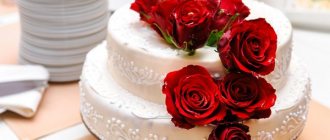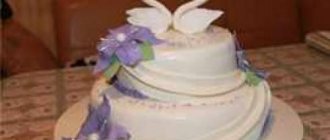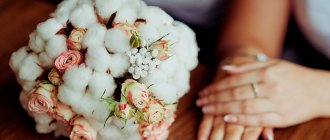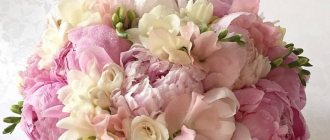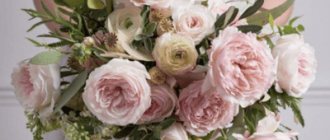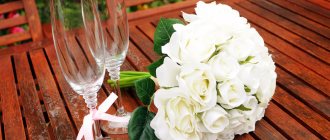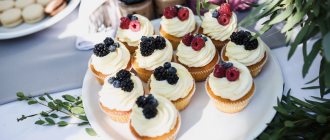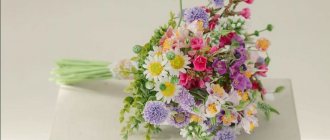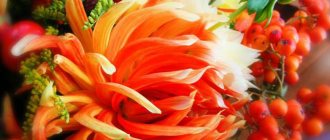Meaning of colors
The language of flowers has long been used to express feelings. On it, hydrangea (another name for this flower is hydrangia) means modesty, truthfulness, faith and hope .
Necessary qualities for a girl entering family life, swearing an oath of fidelity to her lover. Hydrangia given to someone also signifies a declaration of love.
By choosing a wedding bouquet with these flowers, the bride promises her future husband to be a faithful wife, a tender, devoted life partner. Important! It is believed that this lovely flower will bring a calm atmosphere to the home, peace, goodwill, the newlyweds will be healthy, and their family life will be prosperous.
In addition, hydrangea flowers are very impressive and go perfectly with a lush wedding dress. This flower personifies the brilliant beauty of the bride, her uniqueness, her difference from other women on her most special day.
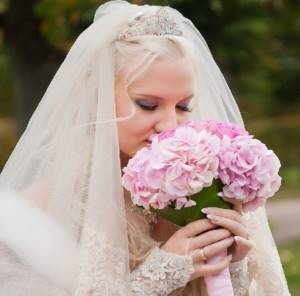
Hydrangea: history and meaning of the flower
The first types of flowers were imported in the 14th century from France and England for the upper classes. And closer to the 18th century, a more widespread large-flowered variety appeared, imported from Japan, and more affordable. Translated from ancient Greek, the name of the flower is a vessel with water. This is due to the special shape of the seed pods, as well as the plant’s moisture-loving nature. However, there are many legends according to which the flower got its name from the female name Hortensia.
In Japan, this flower is considered sacred and has positive energy. It is customary to send a bouquet consisting of large-leaved hydrangeas in blue or light blue to apologize. The flower also has meanings of hope, modesty and sincerity, and drives away misfortunes and illnesses.
How to match a girl's style?
When choosing hydrangea to decorate the bride’s wedding bouquet, you need to consider some points:
- A wedding bouquet, like a dress, should reflect the personality of the bride. The best image is one in which the appearance matches the inner content. A classic composition of hydrangeas will especially elegantly emphasize the beauty of gentle romantic girls;
- A spectacular ball of hydrangia should not be made too large for miniature people , so as not to upset the proportions;
- Tall, slender brides in classic long dresses will benefit from cascading floral arrangements;
- Bright, daring people should add other flowers to hydrangeas , for example, exotic lilies or orchids;
- If the bride wants to emphasize her originality, an asymmetrical bouquet with hydrangeas , which has “disheveled” shaggy outlines, will suit her.
The bouquet should act as a single whole with the overall wedding scenario. Fortunately, hydrangia has many faces. It will decorate a classic lavish celebration, a wedding in a rustic style, or an elegant retro ceremony.
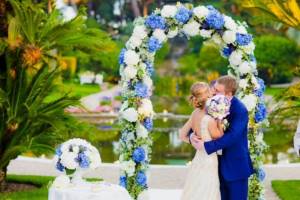
DIY bouquet
Making bouquets with your own hands is one of the leading trends in floristry, which gives everyone the opportunity to test their talents. When working with hydrangeas, you need to answer the question: “What plants do I want to add to ultimately get what I want?” In addition to the freesias and roses mentioned above, hydrangeas also go well with orchids, lilies, callas, and irises. A wide palette allows you to find beautiful color solutions.
It is very important to choose exactly those hydrangea inflorescences that did not dry out on their own, but were cut off by the hand of a caring gardener at the very moment when they were fully in bloom. The guarantee of this is the color you need. With the correct selection of all the necessary components, they look gentle against the background of other details. Unleash your creativity - let your views shape the final look of the composition.
Composition ideas
Brides and wedding florists adore hydrangea for its rich color hues. In addition to classic white, you can choose soft blue, light green, pale pink or lilac.
Lovers of rich, bright colors should pay attention to the rich colors of lush inflorescences - yellow, blue, purple, crimson, lilac. There are few competitors to whom hydrangea is ready to yield in terms of richness and richness of shades.
The most popular color schemes for wedding bouquets with hydrangeas:
- pink shades of flowers for a spring wedding;
- compositions of purple, blue or burgundy tones for an autumn celebration.
Often hydrangia is compositionally combined with other flowers - peonies, roses, orchids, lilies, callas. And here florists have no less room for creativity, for example:
- the “leading” role is assigned to other colors, and hydrangea is used for a spectacular floral background - neutral or contrasting;
- All flowers of the bouquet are selected in a single color scheme, creating a monochromatic composition.
Idea! Mono-bouquets of hydrangea are very popular and are considered a simple, elegant and stylish solution for any look.
Among the flower favorites:
- a combination of white hydrangia with white peonies or roses;
- an alliance of pink hyacinths and matching hydrangeas;
- contrasting “unions” of innocent white and rich purple flowers.
White, blue, dark blue in a mono bouquet
A mono-bouquet is made up of flowers of the same type and color, but a play of shades within the same basic tone is allowed. White, blue and blue hydrangeas are ideal for such compositions:
- Snow-white hydrangia is a light foamy cloud in the hands of the bride. The best addition to a classic romantic look. The personification of the purity and innocence of a young girl entering into marriage;
- Blue hydrangea has a rich color with a milky tint. She looks good with a bolder, edgier look;
- Blue flowers in the bride's bouquet become a bright, noticeable accessory. This original compositional solution suits extraordinary, decisive people.
When composing a mono-bouquet, both larger and smaller flowers are selected.
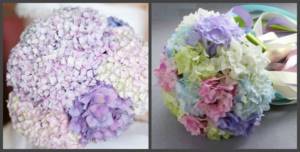
With roses
The combination of hydrangea and rose is often used to create wedding flower arrangements. Lush rose buds are harmoniously complemented by wavy hydrangia petals, forming a beautiful wedding bouquet.
Popular color combinations:
- cream or peach rose buds against a general background of white hydrangeas;
- all shades of pink roses are elegantly combined with purple, blue, lilac hydrangeas, creating a bold, even daring version of the bride’s bouquet;
- large white roses against a background of milky blue small and large hydrangea flowers help to create a romantic, stylish composition;
- contrast of colors, where in a ball bouquet roses and hydrangeas in rich shades, for example, pink, lilac, form clear color sectors.
Interesting options are when small rose buds serve as a background for large, lush varieties of hydrangea.
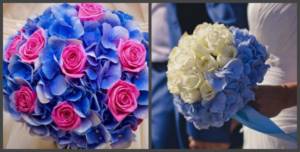
With peonies
Peonies look just as good as roses with hydrangeas. Unlike roses, whose buds are clearly defined, the peony flower is softer and more lush. It does not have a rigid outline and gives the composition lightness, playfulness, and charm. At the same time, peonies can be used to create bouquets of any shape, including classic balls with clear outlines.
Important! Most varieties of peonies bloom in June-July, so a bouquet of peonies and hydrangeas is the recognized king of summer weddings.
Frequently used combinations of peonies and hydrangia:
- white peonies on a colored background of blue, pink or pale green hydrangeas;
- bright color accents of richly colored peonies (red, pink, burgundy) on a white or cream background of hydrangeas;
- A very impressive bouquet that combines small closed and lush open peony buds.
With orchids
The orchid is an aristocratic, exquisite flower. In a wedding bouquet with hydrangeas, the orchid takes center stage due to its spectacular shape. For holiday floristry, the orchid is valuable for its richness of flowers. White, cream, yellow, pink orchids harmonize with the wedding dress. For bold adventurous natures, bouquets with accents of red orchids are suitable.
Of the most popular varieties of orchids for a wedding bouquet with hydrangeas, the following are used:
- cone-shaped vanda;
- large and spectacular cymbidium;
- cascading phalaenopsis.
Different shapes of orchid flowers in combination with hydrangea allow you to create compositions of any shape - classic round, cascading, asymmetrical.
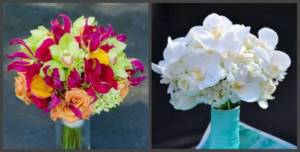
With lilies
No less elegant than the combination of orchids and hydrangeas is a composition with lilies. Lily buds are large, with long graceful petals and a noticeable core. This artsy tropical flower goes well with the delicate wavy caps of hydrangeas, creating an extraordinary composition.
To decorate brides' bouquets, they use all colors of lilies: from classic white, pale yellow and cream to two-color buds. Cute and exotic, for example, white lilies with a juicy pink core or burgundy with white edging of petals. “In the foam” of hydrangeas of a similar or contrasting shade, they look great.
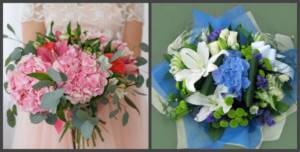
Varieties of colors
It is worth paying attention to the fact that luxurious and large flower clusters of hydrangea shades have made it one of the most popular plants for creating a holiday bouquet for every taste. It is one of the most important accessories in the final image of the bride.
- For a bride who prefers a snow-white dress, a bouquet of blue hydrangea will suit her.
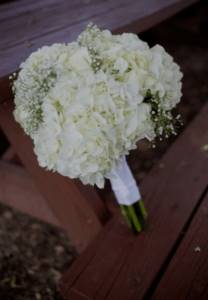
- Displayed in white, the bouquet will tell guests about the tender and romantic nature of the bride.

- To achieve a spectacular, stylish and unique result, a composition with a base of purple hydrangeas is perfect, which will add mystery and sophistication.
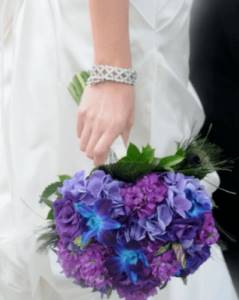
- Do you want to emphasize the lightness and elegance of your image? Choosing a soft pink tone will perfectly cope with this task.
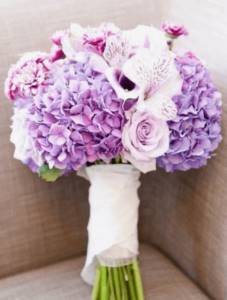
- The blue shade of the bouquet will fit perfectly into the bride’s outfit if it is dominated by light blue details and accessories.
Form
Let us highlight five main forms of bouquets using hydrangeas:
- A sphere is the shape of a ball with a clear outline. It can be made on a leg so that the bride can carry it in her hands. But there is a more original solution - a hanging sphere on a loop tape, which is held with your fingertips or worn on the wrist;
- A hemisphere is half a ball on a leg. Usually the flat side of the bouquet is decorated with lace and ribbons. The shape is clear;
- Asymmetric. In contrast to clear contour solutions with their elegant severity, the asymmetrical bouquet has “disheveled” edges (it is called disheveled), giving the bride’s image lightness and playfulness;
- Cascade. In cascading compositions, flower branches hanging from the main bouquet are created. Chic, but at the same time delicate, sophisticated look;
- Natural. In the natural form of a wedding bouquet, florists strive to emphasize its external simplicity and apparent artlessness.
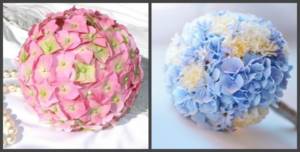

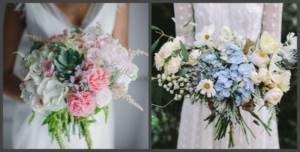
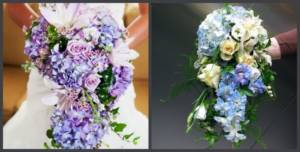
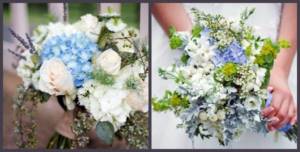
Whatever bouquet the bride chooses, hydrangea will highlight the beauty of the wedding dress and give an unforgettable mood to the young couple’s celebration of love.
Combination of hydrangea with other flowers
At the peak of popularity along with hydrangeas are freesias - graceful, delicate flowers that will help add a pleasant aroma to your wedding bouquet. In this case, you can use hydrangeas as the main background component. You have every opportunity to create a decent bouquet, especially since hydrangeas can look great in different variations.
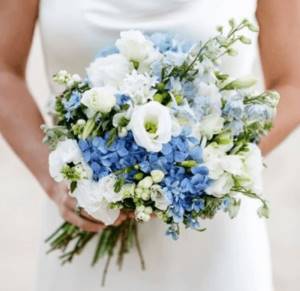
Before you start choosing flowers, you need to decide on the shape of the bouquet that we want to get and determine the possible proximity in it. In our case, hydrangea is combined with almost the majority of flowers used in wedding bouquets, from peonies to roses. The correct use of hydrangea as a base for creating a composition with the addition of freesia and rose flower is guaranteed to provide a confident and discreet solution that will definitely end up in the hands of a young lover.
Decor
Florist designers pay special attention to decorating a wedding bouquet. A spectacular accessory requires a decent frame.
The bride's bouquet of hydrangias is additionally decorated with:
- ribbons of different lengths and textures;
- a cover (corset) for the leg with beautiful embroidery with pearls or rhinestones;
- lace;
- beads, brooch or pendant, which are attached to the bouquet itself;
- a talisman made of a talisman stone.
For original and bold wedding decisions, non-standard decorations of wedding bouquets are used, for example, a rough cord, buttons or letters with the initials of the newlyweds. In combination with delicate hydrangeas, memorable, non-trivial flower arrangements are obtained.

Tree-like
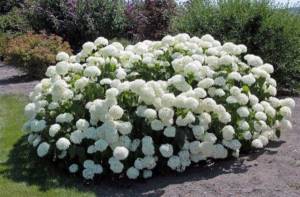
This species is especially popular among gardeners and is most often used in landscape design. It grows in large shrubs 1-3 m high. Only the blossoming buds have a light green tint, but as they open they become cream or snow-white.
The most popular varieties include "Grandiflora" and "Annabelle", which bloom in large inflorescences with snow-white flowers. No less in demand is “Invisible Spirit”, the flowers of which are painted in delicate pink shades.
Bella Anna
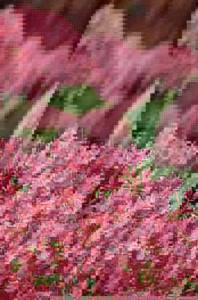
This beautiful ornamental hydrangea blooms with beautiful bright pink flowers, which as they bloom acquire a rich crimson hue.
Incredible
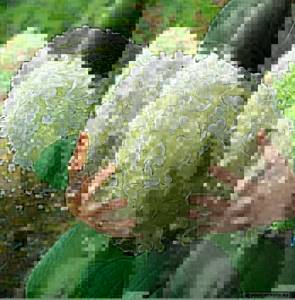
The variety represents shrubs with especially lush white inflorescences. But in Russia this capricious beauty is rarely grown.
How to keep it fresh?
Hydrangia are moisture-loving flowers. The name “hydrangea” itself is derived from two Greek roots: “hydr” (water, moisture) and “ang” (vessel). So the name of the flower reflects its need for constant replenishment with moisture. When choosing hydrangea to create a wedding bouquet, be sure to take this quality into account.
To keep your flowers fresh throughout your wedding, follow these simple rules:
- Choose only freshly cut flowers;
- Before arranging a bouquet, first place the plants in water for several hours so that they are well saturated with moisture;
- Use a porta bouquet holder. This is a special decorated holder for a wedding bouquet, equipped with a floral sponge soaked in water. Flowers in a porta bouquet have access to moisture throughout the holiday.
Advice! If you do not use a porta bouquet maker, make sure that at the holiday there are vases with water nearby, where you will periodically place flowers.
Vanilla Fraze
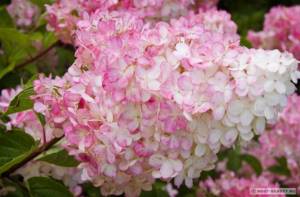
This shrub attracts with dense pyramidal two-colored inflorescences. The top part is white and the bottom part is light pink, making the buds look like an ice cream cone.
Weems Red
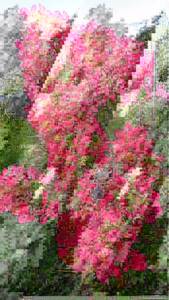
The shrub is one of the frost-resistant varieties. Among others, it is the most attractive due to the original coloring of the petals. When they bloom, they change color from white to red and bright burgundy.
Grandiflora

This beautiful variety is a late bloomer and grows mainly in the southern regions. What makes it especially attractive is the change in shades of flowers several times during the flowering season. Initially the buds are white. As they bloom, they acquire a creamy hue, and at the end they become red-greenish. Even with the capriciousness of cultivation, paniculata Grandiflora is especially loved by gardeners.
Diamond Rouge
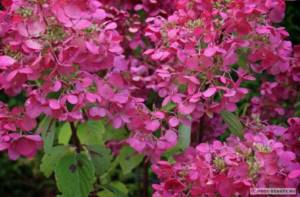
Impressive with colorful flowering with petals changing from snow-white to pink. The emerald leaves, which acquire orange shades with the onset of autumn, also add decorative value.
Pinky Winky (Pinke Winke)
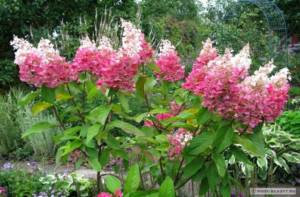
This is a very beautiful variety, delighting with two-color flowering from mid-summer to autumn. The cone-shaped inflorescences are white at the top and purple at the bottom. In autumn, the leaves turn yellow.
Pink Diamond
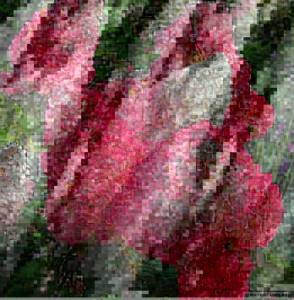
This variety has gained particular popularity among gardeners due to the height of the bushes, reaching 2 m. They are suitable for planting in a large garden area. Paniculata Diamond blooms with beautiful cream flowers, which later turn pink and red.
Sunday Frize
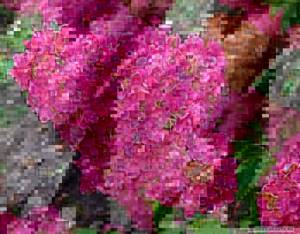
The bushes of this variety of paniculate hydrangeas are distinguished by a spreading crown, which is difficult to give a specific shape. But they are still popular among gardeners because of the special beauty of the inflorescences. Paniculata Fries can change color from pale emerald to soft pink.
Silver Dollar
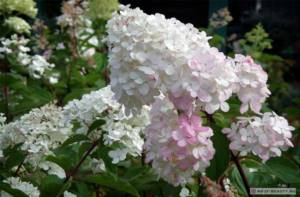
One of the few varieties of hydrangeas that pleases the eye with pale yellow colors. But as they bloom, the buds change color, eventually becoming almost white or silver-pink. The oval-shaped bright green leaves also give the plant a special attractiveness.
Paniculata Phantom
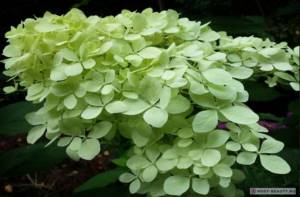
This variety is one of the late-blooming varieties, delighting with its colorful pale lilac blooms from late August to October. A beautiful lush shrub with a spreading crown, Phantom can reach a height of 2 m.
Frize Melba
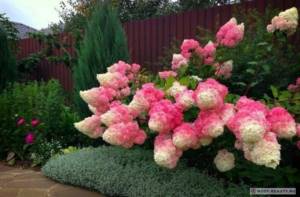
This relatively young hybrid variety was first introduced to gardeners in 2014. But thanks to its ease of care and lush inflorescences, it quickly became popular. The bushes grow slowly, but can reach 2 meters. Fraze impresses with interesting transformations in the shades of flowers. At first they have a milky tint, which turns into light pink and then into wine red. Sometimes on one inflorescence there are flowers of different colors, which gives the plant a bewitchingly beautiful appearance.
Limelight
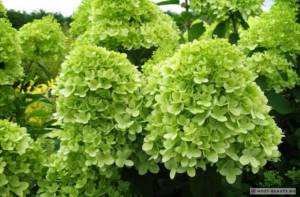
The shrubs reach up to 2 m and bloom with large white inflorescences, which at first have a greenish tint. When grown in the shade, they never turn white.
Kyushu
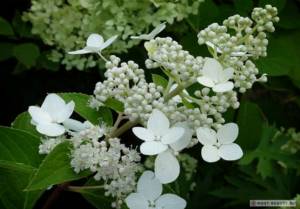
The shrub, up to 2 m high, blooms with beautiful white flowers that have a pleasant aroma. Attracts with long flowering until October.
Magical fire
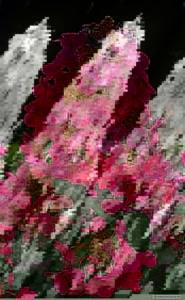
Many people are attracted to this variety by its colorful range of inflorescences. In most cases, the flowers are fiery red in color, which is what gave the varietal name.
Magical Sweet Summer
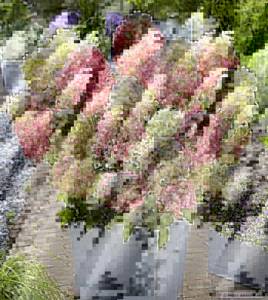
This beautiful ornamental variety has reddish shoots and blooms with greenish-white and subsequently pink flowers from July to September.
polar bear
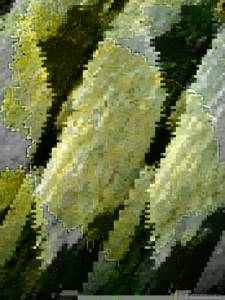
The large flowers received such an interesting name not only for their snow-white color, like the fur of this polar animal, but also for their excellent resistance to frost. This blooming hydrangea delights the eye with its enchanting lush inflorescences.
Airlie Sensation
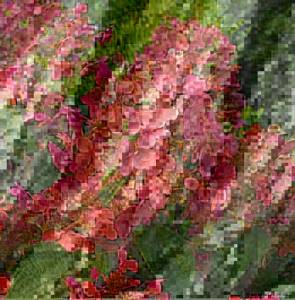
This unpretentious and cold-resistant extensive shrub resembles a miniature lilac, which has won the special sympathy of gardeners. Its lush flowering is especially long-lasting. The flowers are initially cream, then acquire a pink tint, and then become burgundy.
Photo
The uniqueness of a bouquet of hydrangeas is that it suits almost any themed wedding. It looks amazing in luxurious shabby chic style, romantic love is and discreet loft.
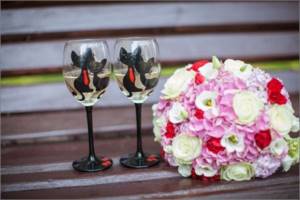
Cult of "Ajisai"
Hydrangea is one of the plants for admiration, the cult of which has long existed in Japan. Its flowering begins in June, traditionally considered the month of rain (tsuyu). During the period when typhoons are raging and cold winds are blowing, the appearance of lush inflorescences - “caps” of lilac, pink, violet and purple shades reminds of bright sunny days and warmth. Gardens, parks and temples are literally buried in clouds of fragrant hydrangea.
The Japanese, families or alone, go to admire this wonderful phenomenon, leisurely stroll along the colorful alleys, take photographs or make sketches. Hydrangea is poetically called “adzisai” - a flower that carries a solar principle. Its breeding is actively carried out in temple complexes, among which the most famous are Hase Kannon and Tahakata Fudo in the Kanto region. There are over 40 varieties of “adjisaya” collected here, of various shapes and shades.
If followers of Shinto simply admire the “flower that carries the solar principle,” Buddhists have also found practical applications for it.
From the leaves of the Hydrangea serrata plant, a very pleasant sweet drink “ama-cha” is prepared, used for ritual purposes.
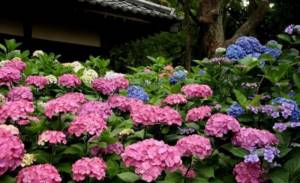
During the Katsubu-e holiday, dedicated to the birth of Buddha, temple statues of the founder of one of the largest religions in the world are poured with this herbal decoction, imitating the bathing ritual. Ama-cha reminds us that when the great Enlightened One was born, hydrangea inflorescences fell from the sky, which have since received the status of a powerful amulet.
According to another legend, the newborn Buddha asked to pour out the drink of immortality - Amrita - on him. Ama-cha replaces the heavenly ambrosia during the "bathing" ceremony. The sweet drink is distributed in temples on the occasion of Buddha's birth and is considered healing. It is taken to friends and family members in the hope of curing them of an illness or to maintain health and strength.
Symbolism
Beloved by the Japanese, “ajisai” serves as a reliable protection against any evil magical influences, helps to establish peace, mutual understanding and harmony in the family, and creates a good, bright atmosphere. A good reason to use it in wedding floristry, where everything is aimed at strengthening the bond between lovers who are married.
Not only in Japan, but also in other Asian countries, brides most often choose pink hydrangea, which in symbolic language means: “You are the beat of my heart.” The larger the size of the “caps”-inflorescences, the deeper the feelings that arise between the newlyweds.
European girls prefer wedding bouquets made of white, blue or blue hydrangea. They are associated with fidelity, purity, modesty and dreaminess, and are evidence of endless love.
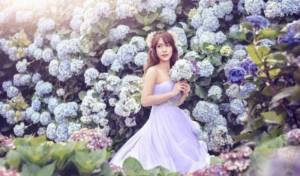
What do hydrangeas symbolize?
Discreet, delicate hydrangea flowers are a feminine flower of success, a symbol of the bride’s modesty and fidelity, her beauty and youth. They emphasize the sophistication and beauty of the bride, allowing her to stand out among others and become a queen at the wedding celebration.
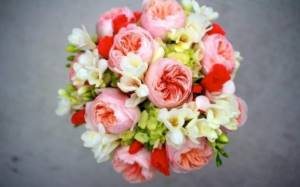
Combination with peons and freesia
A bouquet of hydrangeas given by the groom means his declaration of love to his chosen one and devotion for life.
Among the qualities of this plant is its good nature. It seems to charge the world around us with lightness, joy and goodness, helps smooth out conflicts, and gives peace and prosperity. Therefore, hydrangea is used not only in the bride’s bouquet, but also to decorate the reception hall, wedding tables and the most exquisite dishes.
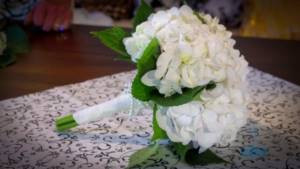
Monobouquet decorated with silk ribbons and beads
Another characteristic of this sweet, delicate flower is its accessibility. The cost of such compositions will suit the newlyweds and will help them save their family budget.
Florist tips for caring for bouquets
If you want lush inflorescences to please you for as long as possible, provide them with plenty of moisture. This advice applies not only to living plants - they need to be watered often - but also to cut branches.
Make sure there is enough water in the vase. At the same time, it does not need to be topped up, but changed completely to prevent rotting of the stems. The buds quickly absorb moisture - it is advisable that the water be fresh and cold.
Cut the ends of the branches with a sharp knife at an angle so as to maximize the area of contact of the stem with moisture. You can add special fertilizer to the vase.
